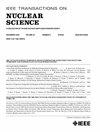ResNeXt Deep Learning Model-Based Transmission Image Reconstruction of Tomographic Gamma Scanning With Array Detectors
IF 1.9
3区 工程技术
Q3 ENGINEERING, ELECTRICAL & ELECTRONIC
引用次数: 0
Abstract
Tomographic gamma scanning (TGS) is a nondestructive testing (NDT) method commonly used for radioactive waste. Traditional transmission image reconstruction algorithms require the projection data to match the line integral value of the reconstructed image in the corresponding projection direction and use a single detector for scanning, resulting in cumbersome and time-consuming scanning processes that severely limit the industrial application of TGS. Sparse angular scanning can effectively improve the efficiency of TGS systems. However, the amount of data generated by sparse angular scanning can make it difficult to support traditional algorithms, resulting in blurry artifacts in the reconstructed image. This work utilizes array detectors to achieve fast and high-precision reconstruction for TGS transmission images under sparse angular scanning, based on the algebraic reconstruction technique (ART) and a new residual networks with next generation (ResNeXt). Geant4 simulation and a self-developed TGS device with array detectors were used for both simulation experiments and real experiments to verify the proposed method. The proposed method was compared to other algorithms, including ART, ART-nonlocal mean (NLM), ART-TV, and ART-DenseNet, using two metrics—mean square error (mse) and structural similarity (SSIM)—for evaluation. The experimental results show that the average mse of ResNeXt is 56.3%, 26.5%, 24.4%, and 8.4% lower than ART, ART-NLM, ART-TV, and DenseNet, respectively. The average SSIM of ResNeXt is 36.4%, 14.8%, 15.3%, and 4.8% higher than that of ART, ART-NLM, ART-TV, and DenseNet, respectively. It can be concluded that when using the same sparse projection data, the improved ART-ResNeXt reconstruction methods generate TGS transmission images with better reconstruction quality and faster reconstruction speed compared to reconstruction methods such as ART, ART-NLM, ART-TV, and ART-DenseNet. The improved ResNeXt exhibits significant adaptability. Even when encountering gamma-ray energy and medium types that are not present in the neural network training set, the reconstruction process achieves the highest quality while maintaining the fastest speed possible.基于深度学习模型的阵列探测器层析伽马扫描传输图像重建
层析伽马扫描(TGS)是一种常用的放射性废物无损检测方法。传统的传输图像重建算法要求投影数据在对应的投影方向上匹配重建图像的线积分值,并使用单个检测器进行扫描,导致扫描过程繁琐且耗时,严重限制了TGS的工业应用。稀疏角扫描可以有效地提高TGS系统的效率。然而,稀疏角度扫描产生的数据量难以支持传统算法,导致重建图像出现模糊伪影。本文基于代数重建技术(ART)和新一代残差网络(ResNeXt),利用阵列探测器实现了稀疏角扫描下TGS传输图像的快速高精度重建。利用Geant4仿真和自行研制的带阵列探测器的TGS装置进行了仿真实验和实际实验,验证了所提出的方法。将该方法与ART、ART-非局部平均(NLM)、ART- tv和ART- densenet等算法进行比较,采用均方误差(mse)和结构相似性(SSIM)两个指标进行评价。实验结果表明,ResNeXt的平均mse分别比ART、ART- nlm、ART- tv和DenseNet低56.3%、26.5%、24.4%和8.4%。ResNeXt的平均SSIM分别比ART、ART- nlm、ART- tv和DenseNet高36.4%、14.8%、15.3%和4.8%。可以得出,在使用相同的稀疏投影数据时,改进的ART- resnext重建方法生成的TGS传输图像比ART、ART- nlm、ART- tv、ART- densenet等重建方法具有更好的重建质量和更快的重建速度。改进后的ResNeXt具有显著的适应性。即使遇到神经网络训练集中不存在的伽马射线能量和介质类型,重建过程也能在保持最快速度的同时达到最高质量。
本文章由计算机程序翻译,如有差异,请以英文原文为准。
求助全文
约1分钟内获得全文
求助全文
来源期刊

IEEE Transactions on Nuclear Science
工程技术-工程:电子与电气
CiteScore
3.70
自引率
27.80%
发文量
314
审稿时长
6.2 months
期刊介绍:
The IEEE Transactions on Nuclear Science is a publication of the IEEE Nuclear and Plasma Sciences Society. It is viewed as the primary source of technical information in many of the areas it covers. As judged by JCR impact factor, TNS consistently ranks in the top five journals in the category of Nuclear Science & Technology. It has one of the higher immediacy indices, indicating that the information it publishes is viewed as timely, and has a relatively long citation half-life, indicating that the published information also is viewed as valuable for a number of years.
The IEEE Transactions on Nuclear Science is published bimonthly. Its scope includes all aspects of the theory and application of nuclear science and engineering. It focuses on instrumentation for the detection and measurement of ionizing radiation; particle accelerators and their controls; nuclear medicine and its application; effects of radiation on materials, components, and systems; reactor instrumentation and controls; and measurement of radiation in space.
 求助内容:
求助内容: 应助结果提醒方式:
应助结果提醒方式:


